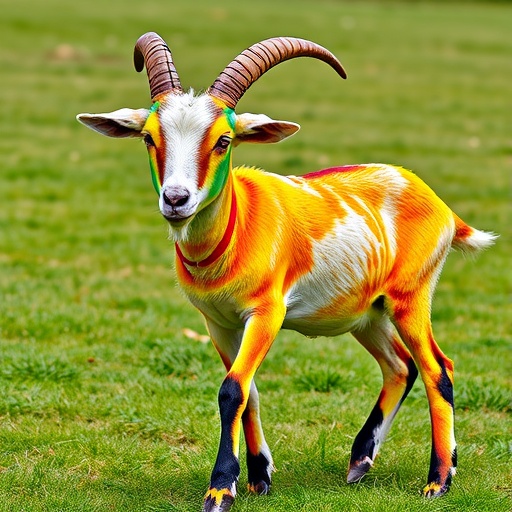In a groundbreaking study, researchers have unveiled significant insights into the genetic architecture of Tianfu goats, particularly focusing on the structural variations influencing their distinctive pigmented spot sizes. This research, conducted by a team led by Guo, Huang, and Xiang, utilizes whole-genome sequencing methodologies to delve into the intricacies of goat genetics, uncovering potentially transformative information for livestock breeding practices. The implications of such discoveries could not only enhance our understanding of these animals but might also provide broader insights into the genetic bases of coloration in other species.
Tianfu goats are renown for their striking appearance, characterized by a unique pattern of pigmented spots on their coats. These spots contribute not only to the aesthetic appeal of the goats but also serve as a phenotypic marker of genetic variation within the breed. Given the economic importance of goat farming across various regions, particularly in China, understanding the underlying genetic factors that contribute to desirable traits like coat coloration has significant agricultural implications.
The research team employed advanced whole-genome sequencing techniques to meticulously map the genome of the Tianfu goats. This sophisticated approach allowed for an unprecedented level of detail, uncovering the genetic code that informs physical traits, including those specific to coat pigmentation. The resulting data sets provided a clear window into the complex structural variations present at specific loci related to pigmented spot sizes, revealing a rich tapestry of genetic information.
One of the most striking findings from this genomic analysis was the identification of numerous structural variations that had previously eluded researchers. These include insertions, deletions, and duplications within the goat genome that correlate with variations in spot sizes. By employing bioinformatics tools to assess these structural variations, the researchers were able to delineate the genetic landscape that influences these traits, setting the stage for further investigations into the evolutionary significance of such polymorphisms.
The implications of these findings extend beyond Tianfu goats; they contribute to a growing body of knowledge surrounding the genetics of coloration in domesticated animals. Color patterns in livestock have long been a subject of interest, directly influencing breeding decisions among farmers. Understanding the genetic determinants of these traits provides a powerful tool for breeders to enhance desirable characteristics in their herds, leading to more successful farming practices and potentially higher economic returns.
Moreover, this research highlights the importance of structural variants as crucial elements in genetic diversity. While single nucleotide polymorphisms (SNPs) have traditionally been the focus of genetic studies, the role of structural variations is increasingly being recognized as a key contributor to phenotypic diversity. This study underscores the need for a more nuanced approach to genetic research that encompasses both point mutations and larger-scale genomic alterations.
The methods employed in this research also underscore the rapid advancements in sequencing technology, which have dramatically increased the speed and accuracy of genomic analyses. High-throughput sequencing techniques allowed the researchers to gather comprehensive genetic data, paving the way for a deeper understanding of complex traits in various species. As technology continues to advance, we can expect further revelations in genetic research that will illuminate the pathways of evolution and adaptation in the animal kingdom.
The ethical implications of this research cannot be understated. As genetic editing techniques become more refined, understanding the genetic basis of desirable traits is critical for responsible breeding practices. The findings from this study could guide future genetic editing efforts, ensuring that desired traits can be enhanced without compromising the overall health and well-being of the animals involved. Such ethical considerations are vital as the agricultural community seeks to balance productivity with humane treatment of livestock.
Researchers are optimistic that the insights gained from studying Tianfu goats may have broader applications in genetic research and animal husbandry. The potential to harness genetic information from one species and apply it to others could revolutionize breeding practices across numerous livestock categories. For instance, the lessons learned from the pigmentation genetics of goats could be extrapolated to cattle, sheep, and even companion animals, paving the way for an era of personalized animal breeding.
In conclusion, the pioneering work presented by Guo, Huang, Xiang, and their collaborators marks a significant advancement in the field of genetics. By utilizing whole-genome sequencing to illuminate the complexities of structural variations in Tianfu goats, this research offers valuable insights that could reshape the landscape of livestock breeding. The fusion of advanced technology with groundbreaking genetic research holds the promise of not only enhancing agricultural productivity but also ensuring that ethical standards are met in the process.
As we move forward, the stakes remain high for both scientific inquiry and agricultural industry stakeholders. Understanding the genetic underpinnings of traits such as pigmented spot sizes in Tianfu goats is just the beginning. The collaborative efforts in this field indicate a future where robust genetic data will inform agricultural practices, blending technology with tradition to benefit both farmers and animals alike.
With these findings contributing to a more comprehensive understanding of livestock genetics, we are poised to enter a new era in agricultural science. The research community is invited to build upon this foundation, leveraging the insights gained to foster the continued progress of genetic studies and their applications in farming.
Subject of Research: Tianfu goats and genetic variations influencing pigmented spot sizes.
Article Title: Whole-genome sequencing reveals complex structural variations at a major locus linked to pigmented spot sizes in Tianfu goats.
Article References:
Guo, J., Huang, Q., Xiang, Q. et al. Whole-genome sequencing reveals complex structural variations at a major locus linked to pigmented spot sizes in Tianfu goats. BMC Genomics 26, 848 (2025). https://doi.org/10.1186/s12864-025-12055-1
Image Credits: AI Generated
DOI: 10.1186/s12864-025-12055-1
Keywords: Tianfu goats, whole-genome sequencing, structural variations, pigmentation genetics, livestock breeding.




